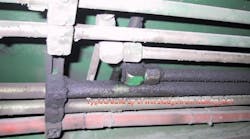Hydraulic oil leaks are often considered to be an inherent characteristic of hydraulic machines. While this may have been true 30 years ago, advances in sealing technology and the development of reliable connection systems means that today, leak-free hydraulic plumbing is readily achievable.
Reliable Connections
Leak-free reliability begins at the design stage, when the type of hydraulic fitting is selected for port, tube-end and hose-end connections.
Ports - Connectors that incorporate an elastomeric seal such as UN O-ring, BSPP and SAE 4-bolt flange offer the highest seal reliability. NPT and BSPT are the least reliable type of connector for high-pressure hydraulic systems because the tapered thread itself provides a leak path. The threads are deformed when tightened and as a result, any subsequent loosening or tightening increases the potential for leaks. In existing systems, tapered thread connections should be replaced with UN O-ring or BSPP for leak-free reliability.
Tube and Hose Ends - ORFS tube and hose end connections feature the high seal reliability afforded by an elastomeric seal but, due to its cost, ORFS is not as widely used as compression fittings and JIC 37-degree flare.
Flared connections have gained widespread acceptance due to their simplicity and low cost. However, the metal-to-metal seal of the flare means that a permanent, leak-free joint is not always achieved, particularly in the case of tube-end connections.
Leaking flare joints can be eliminated using a purpose-built seal developed by Flaretite. The Flaretite seal is a stainless steel stamping shaped like a JIC nose, with concentric ribs that contain pre-applied sealant. When tightened, the ribs crush between the two faces of the joint, eliminating any misalignment and surface imperfections. The combination of the crush on the ribs and the sealant ensure that a leak-free joint is achieved.
Incorrect Torque
A common cause of leaks from flare joints is incorrect torque. Insufficient torque results in inadequate seat contact, while excessive torque can result in damage to the tube and fitting through cold working.
Vibration
Vibration can stress plumbing, affecting hydraulic connector torque and causing fatigue. Tube is more susceptible than hose. If vibration is excessive, the root cause should be addressed. Ensure all conductors are adequately supported and if necessary, replace problematic tubes with hose.
Seal Damage
Having outlined the benefits of hydraulic fittings that incorporate an elastomeric seal, it is important to note that their reliability is contingent on fluid temperature being maintained within acceptable limits. A single over-temperature event of sufficient magnitude can damage all the seals in a hydraulic system, resulting in numerous leaks.
Conclusion
A leak-free hydraulic system should be considered the norm for modern hydraulic machines - not the exception. This means the improper selection, installation and maintenance of hydraulic plumbing can be a costly mistake. And to discover six other costly mistakes you want to be sure to avoid with your hydraulic equipment, get "Six Costly Mistakes Most Hydraulics Users Make... And How You Can Avoid Them!" available for FREE download here.

Continue Reading
Continue Reading
BOOK 2, CHAPTER 12: Fluid Motor Circuits
March 18, 2009
Motor leakage variations
Oct. 18, 2006
Sponsored Recommendations
Sponsored Recommendations
All-In-One DC-UPS Power Solutions
March 13, 2024
Motor Disconnect Switches
March 13, 2024
Industrial Straight-Through Cable Gland
March 13, 2024
